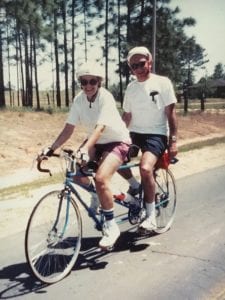 Pat Jahoda has taken the BTV stage at least a dozen times. Seated at the Yamaha Grand Piano, wearing her trademark dark-rimmed glasses, this formally trained pianist can bring the Performance Hall to a hush with the masterworks of Brahms or Chopin — her favorites — or delight the audience with a rousing program of pedal-pumping ragtime.
Pat Jahoda has taken the BTV stage at least a dozen times. Seated at the Yamaha Grand Piano, wearing her trademark dark-rimmed glasses, this formally trained pianist can bring the Performance Hall to a hush with the masterworks of Brahms or Chopin — her favorites — or delight the audience with a rousing program of pedal-pumping ragtime.
As a young girl and then teenager, Pat Jahoda’s talent as a pianist was well recognized. She taught herself how to play, completed graduate studies in music, and never lost her love for it. Yet she paused her talent for a full 22 years, and she’s now rediscovering what she’d done so well in the past.
Since moving to Butterfield in 2016, Pat has taken a lead role in piano performance at the Village. She accompanies the BTV Chorus, collaborating with choral conductor Rager Moore to present a number of Broadway music programs and the music of Cole Porter and George Gershwin.
As a solo performer, Pat has performed ragtime, the music of 19th century female composers, and the BTV original Ebony and Ivory Series, a split billing with fellow resident/pianist Sue Gohn.
“Butterfield has provided me with the opportunity to really study my music,” Pat Jahoda said. “Everyone here has been so supportive and their encouragement gives me the motivation I need to keep learning.”
Early in life, Pat played well enough to perform recitals. Music helped define her path, and it became central to three college degrees she earned as
an adult.
“I am captivated with music,” Pat said. “Brahms, Chopin, ragtime, a little jazz, old country, ‘40s-‘50s type ballad country. I like it all. I love to study music and I love to play. Here at BTV, I can practice in the middle of the night if I want. My piano (in her home) is a hybrid and I can turn it down so only I can hear.”
For someone so immersed in music early on and then again today, it’s hard to believe she didn’t touch a piano for more than two decades.
“I had a new priority at this time in my life,” Pat said. “I was helping my husband continue his work. Due to his blindness, he was technically disabled. He could have been disabled, but I would not let him be.”
A DESIRE TO PLAY
Pat started playing the piano at age 8. She improvised and played by ear before beginning piano lessons. Growing up in several states in the South and the Midwest, Pat studied and played the piano while at St. Mary’s Academy in Little Rock, and she earned a bachelor’s degree in music at what’s now Webster University in St. Louis in 1960.
Pat then attended Our Lady of the Lake University in San Antonio and within six years earned a second bachelor’s degree, this time in music education. From there, she came to Fayetteville and earned a master’s degree in piano performance at the University of Arkansas.
With music as a guiding factor in her life, Pat relocated to Batesville, Ark., where she opened a piano studio. She ran the studio and gave private lessons there for eight years.
Pat was soon on the move again. She was accepted into a doctoral program in music education at Florida State University and made the 650-mile move to Tallahassee.
As rewarding as music was, Pat sought a forward-looking career in a profession that could challenge and sustain her. She left the music ed program and transferred across FSU’s moss-draped campus to the School of Library Science and Information Studies.
“That is when my life began,” she said.
LOVE IN THE SUNSHINE STATE

Saying “I do” in Florida
In Tallahassee, Pat wanted to experience an education beyond the classroom, and did so in a number of ways. Her life became so diversified and her contributions immense.
Pat became a certified, volunteer conflict-resolution mediator in Leon County small-claims court. She volunteered with the American Red Cross, interviewing clients who needed utility assistance. She also devoted countless hours volunteering for chemotherapy patients at Tallahassee Memorial Hospital.
“When you’ve spent half your life in a (piano) practice room, you want to get out and learn about life,” Pat said, looking back. “I felt like I needed to broaden my scope and horizons, and these volunteer activities were a worthwhile way of doing it.”
Pat, who was in her 40s at the time, reveled in exploring fine arts and theater in Tallahassee, a place she described as wonderful and cultural. She belonged to a theater production group and sang with the Tallahassee Community Chorus.
She soon met Gery Jahoda, a respected professor at the FSU School of Library Science and Information Studies. Gery, who was legally blind, was a skilled and dedicated professor who’d blazed trails at FSU in the emerging field of information science.
In 1980, Gery Jahoda advertised for a research secretary, and Pat Brown was one of the grad students who applied.
But guess what? Gery didn’t hire her, yet the two struck up a friendship that would evolve into something more. Pat soon discovered that when you love someone who is legally blind, you learn when it’s time to step in and help navigate and when it’s best to step aside.
Gery was born in Austria, and his family fled Europe to escape the threat of Nazis during World War II when he was 14. The circumstances were dire, but they were able to emigrate from France to the U.S. and settle in New York.
As a young man, Gery was in the U.S. Army stationed in Texas in 1944 when he received a life-changing diagnosis: He had retinitis pigmentosa – a rare eye disease that can lead to blindness.
Undeterred, Gery studied at New York University and worked as an industrial chemist and the chemistry librarian at the University of Wisconsin. He went on to earn a doctorate in library science at Columbia University, while directing technical information centers at Colgate-Palmolive and the Esso Research and Engineering Company.
When Pat met Gery at FSU, his career was thriving. Yet, outside of the classroom, he was grieving from the death of his first wife, Gloria Jahoda, a published author.
One day, Pat did something unexpected. She bought a rusty, Schwinn tandem bicycle and had it renovated. She showed up after Gery’s class on the bike. Without missing a beat, he hopped on the back and off they rode.
“We were such good friends,” Pat said. “I knew that even if it ended up that we did not get married, I was going to stick around and be his friend. I wanted him in my life one way or the other. He was that special.”
TWO ON A TANDEM

Pedaling partners on a tandem
Pat did not play the piano from 1980 to 2002. She had a new priority in her life: her husband, Gery. They married in 1982 after Pat finished her master’s degree in library science. They spent more and more time riding their tandem, training for longer, harder rides.
“I would take the bike and pick him up at work, at school,” Pat said. “He’d come out with his briefcase under his arm. It was one speed, but we took all the hills. We got to where we could ride 25 miles with hills, and we were pretty proud of that.”
Pat held the front seat as “captain” with Gery behind her as the “stoker.” As the captain, Pat guided the bike and handled the brakes; he provided pedal power and support from the back. Pat would communicate to Gery about what was ahead — hills, surface changes, whatever — and even described the scenery.
“My husband with limited sight taught me to anticipate what I could do to make his life easier and better,” Pat said. “He was so positive and unafraid to face a challenge. I told him with both of us working together, we could venture forth and have many experiences.”
From 1985 to 1993, they rode across parts of Florida, and they sometimes journeyed north into Georgia. On weekends they rode to the Gulf Coast and back, which was 67 miles. All their efforts culminated in a summertime trip to Europe. For six and a half weeks, the Jahodas tooled around on bike paths in West Germany, Belgium, Holland and France.
“Riding the tandem gave us a feeling of freedom and adventure,” Pat said. “Our cycling trip to Europe was an extension of these feelings. We also did two backpacking trips in Europe. We met people in various countries and in small villages and were received with warmness and curiosity about our ventures.”
A NEW TURN
Gery rode into his ‘70s, only a few years before his 2003 death at age 77. Pat eventually left Florida and returned to Fayetteville. When she felt it was time to consider retirement options, she was impressed by Butterfield’s status as the only CCRC in Arkansas, among other benefits.
She began playing the piano almost immediately. First as an accompanist for the BTV Chorus, and later working with Programs and Events Department Director Riki Stamps and Assistant Director Michael Burks to produce and present entire piano programs to large audiences in the Performance Hall.
When she’s not performing, Pat enjoys studying in the music library she created in her home. She listens to a podcast of Performance Today with Fred Childs each morning. At least once a day, she practices on the Casio piano in her living room.
“Music is who I am, and it will be a part of me forever,” she said.
